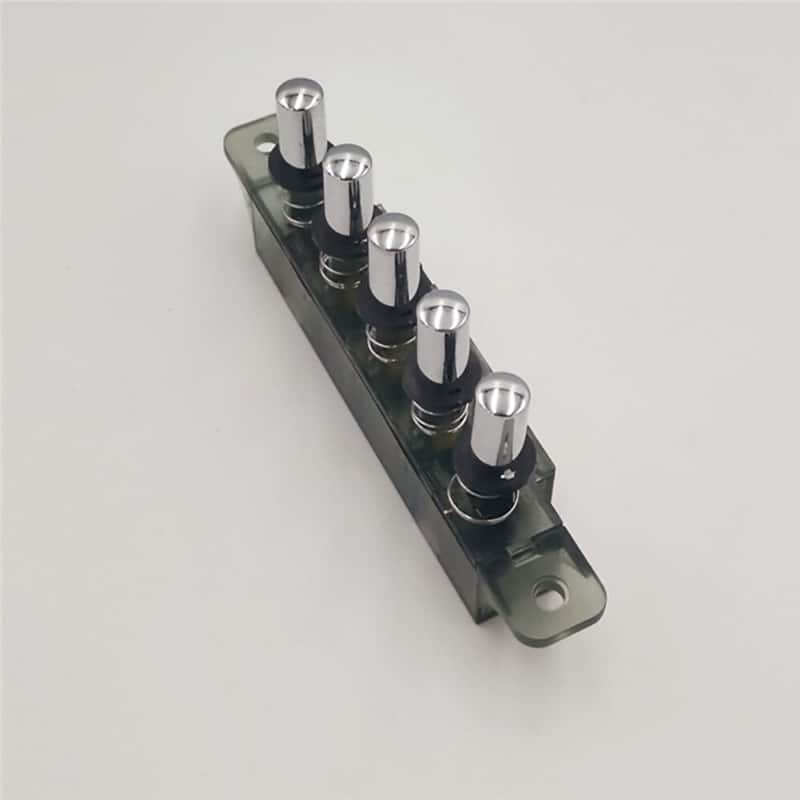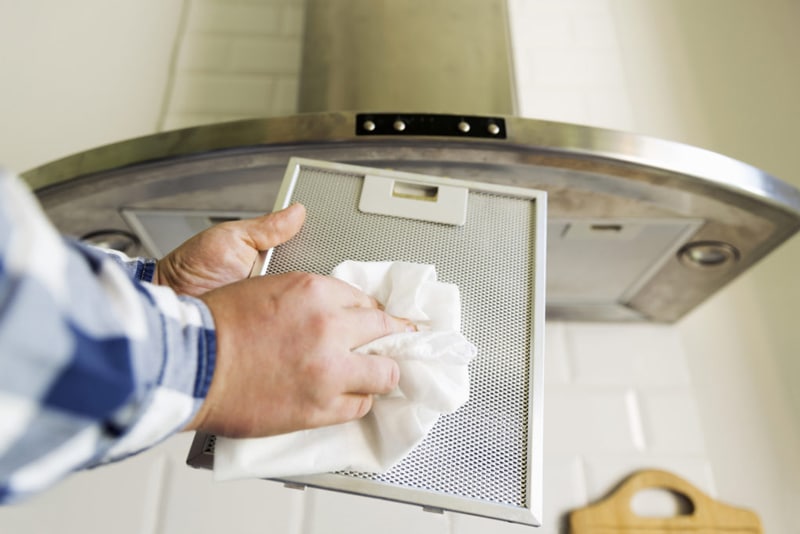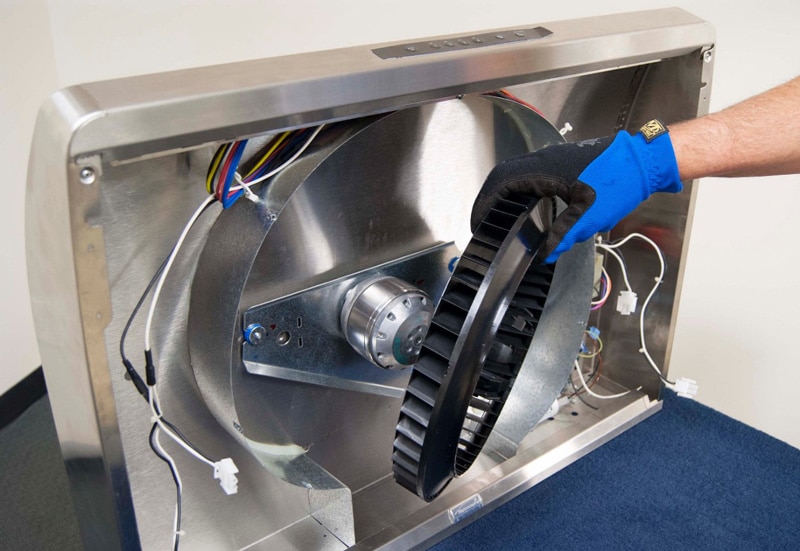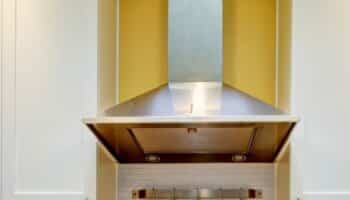Is your range hood not working, and you’re trying to figure out why?
That’s too bad! Range hoods are wonderful appliances that help keep our kitchens smoke-free and strong smells under control. However, as great as they are, range hoods are also known for presenting a wide variety of issues over time.
I know how frustrating it can be to have your range hood fail on you – especially when you’re working against the clock trying to get meals ready for a family get-together or a big social event. But don’t worry; you’ve come to the right place for answers. Below, you’ll find a list including 7 common problems that can make a range hood stop working, as well as simple solutions for each one.
When your range hood isn’t working, it can mean it’s having power issues, switch issues, light and fan issues, and airflow problems. It’s also possible that your range hood has a motor that works intermittently, makes too much noise, or is simply unresponsive.
Keep reading to get your range hood working again!
Why Your Range Hood Isn’t Working
Range hoods are not the most complex appliance on the market, and yet, there are many possible reasons why they fail when they do. From something as simple as a bad or loose connection to a more complex issue, such as a broken motor, the possibilities are nearly endless.
However, over the years, I’ve found that some causes are more common than others when it comes to a faulty range hood. To help save you time, effort, and money, here are the most common issues when a range hood isn’t working.
#1 Power Issues
Let’s start off by talking about range hood power issues. It’s possible for your range hood to stop working one day out of nowhere, and it can happen for various reasons.
In my experience, range hoods will have power issues when there’s either a short circuit inside them or the breakers supplying power to them have been tripped. Tripped breakers can happen due to power surges caused by blackouts or damaged wiring inside your range hood.
Solution: The easiest way to tell whether your range hood is having power issues due to bad internal wiring and tripped breakers is to check both elements thoroughly.
- Go to your home’s circuit breaker area and check whether the switch supplying power to the kitchen is flipped to the “ON” position. Another simple way of telling the switch’s position is by checking if the rest of your kitchen appliances have power (i.e., the fridge, microwave, etc.).
- Once you’re sure the breaker switch is not to blame, you’ll need to check the appliance’s internal wiring.
- Before going inside the range hood, please flip the kitchen’s circuit breaker switch to the “OFF” position to prevent the risk of electrocution.
- Remove the range hood’s grease filter. You’ll see a bunch of connections and the internal part of the button assembly.
- Ensure there are no loose, frayed, or damaged cables that could be causing a short circuit.
If you fail to spot anything out of the ordinary, there’s a good chance the issue is related to a more complex fault in your home’s electrical layout. Please get in touch with a technician at this point to investigate further.
#2 Faulty Switches
The next possible reason why your range hood isn’t working is that the external button controls are either broken or failing.
Depending on your range hood’s brand and model, there will likely be an on/off button. When you press the button, a switch is activated in the internal control board, prompting the appliance to start pulling in air. If you notice your range hood isn’t working when you press the power button, there’s a good chance the switch behind the activation button is faulty.

Solution: I’ve found that checking for bad button switches and addressing the issue can be very simple and quick. All you need to do is follow some simple steps:
- Cut off power to your kitchen from your circuit breakers.
- Remove the grease filter from your range hood (and use this opportunity to replace it with a new one if it’s dirty).
- Look inside the range hood’s compartment and locate the button assembly.
- Carefully unplug the assembly from the rest of the appliance’s wiring and replace it with a new assembly.
- Restore power to the kitchen and see if the buttons activate the range hood.
If you don’t want to spend money on a new range hood button assembly before being 100% certain the switch is to blame, you can also use a multimeter to test the button assembly for proper continuity.
Provided you replace the button assembly with a new one and your range hood still isn’t working, that’s okay. There’s still a lot of ground to cover.
#3 Faulty Lights/Fan
Next, let’s talk about faulty lights/a faulty fan when your range hood isn’t working.
Similar to the previous issue, you might notice that when you’re trying to activate your range hood, the lights won’t come on, or the fan that pulls in the air won’t activate. Depending on other signs you notice, the issue can either be fully isolated to the fan or the lights, or it can be a general failure.
My usual advice when troubleshooting such an issue is to try to activate the fan and the lights separately. If the fan turns on, but the light doesn’t, chances are it’s just the light that needs replacing. However, if everything seems to be working normally, but the fan won’t come on, there’s a good chance something’s wrong with the motor.
It’s also possible that the fuse inside the range hood has blown, in which case, you’ll have to replace it as soon as possible.
Solution: If the range hood works fine, but there’s no light, replacing the light is simple:
- Cut off power to your kitchen via your circuit breakers.
- Locate the light bulb in the range hood and carefully start twisting it to the left.
- Once removed, please get a new light bulb and place it in the appliance’s socket.
Provided you’ve replaced the bulb, and there’s still no light or fan activation, the next thing you’ll need to check is the fuse. Your range hood’s fuse will blow to protect your appliance whenever there’s a massive power surge or a short circuit.
On the upside, a blown fuse means your range hood was protected against dangerous currents, but on the downside, it also means that the appliance won’t work until a new fuse is installed. Here’s what you have to do:
- Ensure there’s no power going into your kitchen.
- Check your range hood’s wiring diagram to know exactly where the fuse is, as the location varies from one model to another.
- Once you know the fuse’s location, gain access to it and use a multimeter to test it for continuity.
- Inspect the fuse for signs of damage.
If your multimeter shows no continuity, the component is faulty and must be replaced as soon as possible. You can check your User Manual to find the right part model number. If you no longer have the manual, please refer to our free resource below.
If the fuse is to blame for the issue, I find that the replacement typically does the trick and gets everything back to normal.
#4 Airflow Issues
Airflow is a key part of any range hood, so when it’s affected in any way, it’s normal to wonder why the appliance doesn’t seem to be working anymore.
Range hood airflow depends on several factors, including the grease filter, the fan, and the exhaust duct. When any element is not working as expected, the entire process can be greatly affected. As I mentioned earlier, poor fan functioning can be due to a blown fuse or motor failure; however, it’s also possible that there’s obstruction present.
Over time, grease and food particles collect on your range hood’s grease filter and the appliance’s internal components as well. If you don’t clean the unit often, issues will surely arise.

Solution: Let’s start simple and clean/replace the grease filter.
According to most manufacturers’ recommendations, you must clean your grease filters once every couple of weeks/months and replace them every other year to ensure proper airflow. You can use water and detergent to clean your range hood’s filters.
Assuming the filters are clean enough, let’s move on to considering a fan obstruction. From what I’ve seen over the years, if anything is preventing your range hood’s fan from spinning freely, the appliance won’t be able to pull in as much air as it’s capable of. To check the fan:
- Cut off power to your kitchen via your circuit breakers.
- Check a diagram for your range hood’s layout to understand exactly how to access the fan, as the process varies from model to model.
- Once you have clear access to the fan, check it for obstructions. Ensure the fan blades are in good condition and that nothing is loose or improperly placed.
A good sign that the motor is okay but something is affecting the fan is that you hear a motor sound when activating the range hood, but the fan doesn’t move.
The last possible explanation for poor airflow is a blocked exhaust duct. If anything is blocking the exit of air and smoke to the outside world, it can seem like your range hood isn’t working. Checking the duct is a bit more complex than checking the fan and replacing the grease filters, so my usual advice in such cases is to contact a professional for help.
#5 Intermittent Motor Functioning
Intermittent motor functioning can also explain why your range hood seems like it isn’t working. The motor inside your range hood is responsible for activating the fan that pulls in unwanted smoke and smells as you cook.
When the motor fails, you’ll notice not enough air is removed from your kitchen, which should be the first sign that something’s not right. A faulty motor (i.e., a motor that’s not making the fan spin) can be caused by overheating of the appliance, short circuits, and more.
Solution: The simplest way to tell whether your range hood’s motor is faulty is by activating it to pull in air and observing how the appliance works. If the motor runs for a while and then stops, it’s a clear sign that it’s either overheating or failing to sustain enough power to keep working.
Range hood motors are complex, so I don’t recommend you try to address the issue yourself. Please get in touch with a professional technician and have them diagnose the problem and fix it. Depending on your range hood’s model, the motor replacement can be more or less expensive.
#6 Excessive Noise
Excess noise coming from your range hood is not always an issue that requires replacing parts or fixing components; still… it can be very annoying and trick you into thinking something’s not working quite right.
When dealing with a noisy range hood, the most likely explanation is that something is loose inside the appliance or that the motor bearings need lubrication. In my experience, loose screws, vent ducts, and even erratic fan movement can make a lot of noise as air flows inside the unit.

Solution: You’ll need a screwdriver and some patience to check every nook and cranny of your range hood and try to spot anything that needs tightening.
It’s important that, when you get to the fan area, you not only ensure the blades are sitting tightly but also that there are no signs of scrapping in the walls around them, as that can indicate erratic fan movement that must be addressed.
If you suspect poor fan bearing lubrication, I recommend you do some research and buy a product to apply to the bearings to stop the excessive noise.
#7 Unresponsiveness
Lastly, let’s assume unresponsiveness is the symptom that’s keeping you stuck trying to fix a range hood that isn’t working.
In my experience, range hood unresponsiveness is typically general. In other words, when your range hood fails to react to the pressing of its buttons and the dialing of certain settings, in most cases, everything else will also fail.
Such widespread failure is usually related to a fault with the Control Board, which, in a nutshell, is your range hood’s brain. Through the Control Board, the range hood communicates with its internal components and adjusts settings, such as fan speed, according to your inputs.

Solution: When a range hood’s Control Board is faulty, the safest course of action is to test and replace the component. However, depending on your unit’s brand and model, the replacement can sometimes not be the most cost-effective solution.
My usual advice is to do research on the potential cost of replacement and get quotations from several vendors to ensure you get the best bang for your buck.
Fixing a Faulty Range Hood
That about covers it!
When your range hood isn’t working, a thousand thoughts can rush to your head, including the potential cost of repairs that you’ll have to cover to get a chance at getting everything back to normal.
Luckily, as I hope this piece has helped you better understand, addressing the most common causes behind a range hood that isn’t working can be easy, quick, and cheap. More often than not, something simple, like cleaning the grease filter and replacing the fuse inside the unit, will do the trick.
Thanks for reading. If this article was useful and answered your questions, please check out our other resources and free guides below and consider subscribing to our newsletter.
Have a wonderful week!
-Craig.








